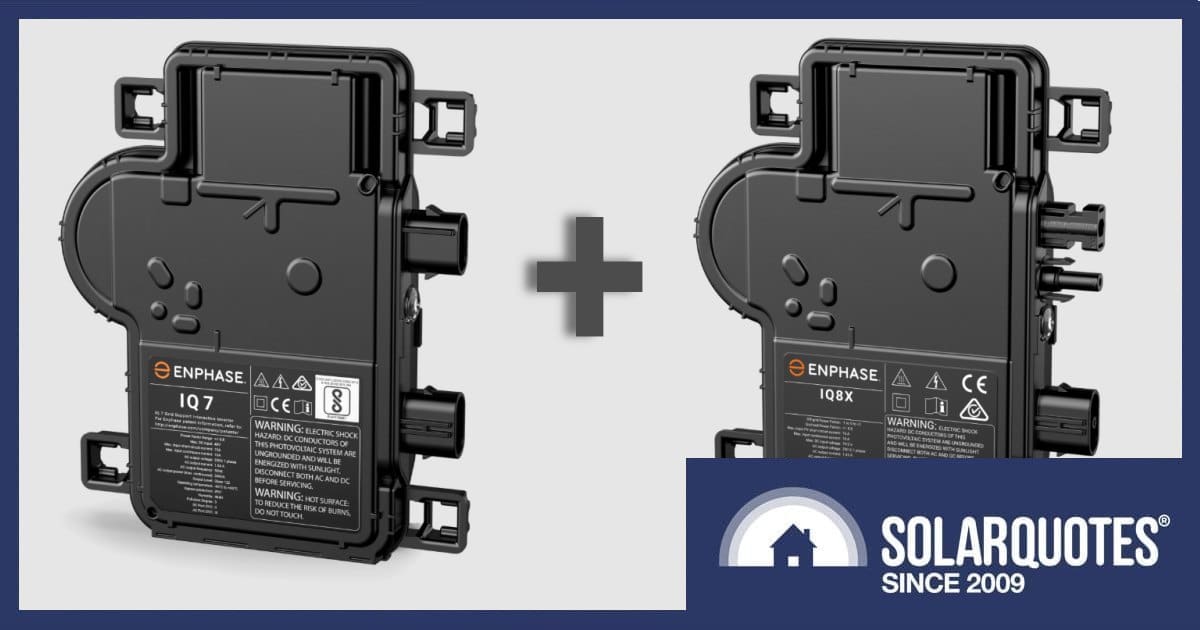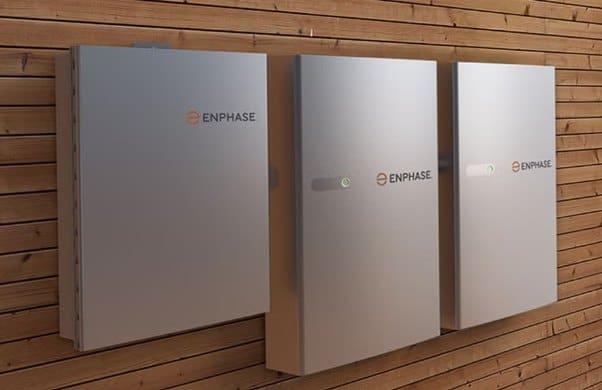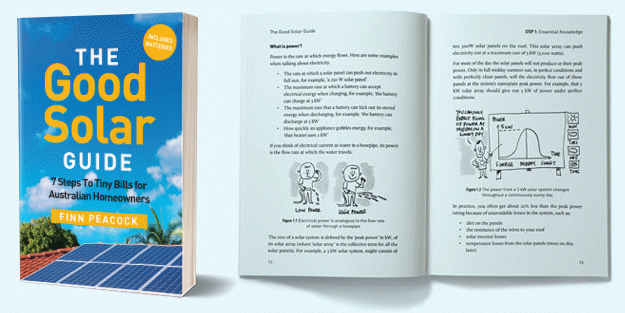
Microinverter and energy storage manufacturer Enphase announced last week that Australian owners of IQ7-based microinverter systems can expand their solar capacity using IQ8 devices. Plus, news of a recent addition to the company’s Australian energy storage solutions range.
Mixing IQ7 And IQ8 Microinverters: The Solution
Following a launch earlier this year across North America, Europe and several other markets, software enabling the IQ8 and IQ7 to work together has been made available in Australia, India, South Africa, and the Philippines. For Australian homeowners with existing IQ7 systems, they’ll also be able to add compatible energy storage under a mixed microinverter scenario.
“With this upgrade and appropriate configuration, systems can seamlessly generate, store, and supply power during grid interruptions – supporting increased self-consumption, backup capability, and long-term energy independence,” says Enphase.
Previously, IQ7 microinverters couldn’t mix with IQ8 on the same IQ Gateway (formerly known as Envoy), or combiner box with built-in Gateway1 due to the latest generation device using a new form of PLC (power line communications) that wasn’t backwards- compatible.
The situation would have frustrating for some of the one million households worldwide using the IQ7, as owners wanting to expand their systems were faced with three choices — running two systems with two Gateways, replacing all their micros with IQ8 units, or adding more IQ7 microinverters; which are still available in Australia.
How It’s Done
Enphase Software Version 8.3.5225, with Installer App 4.8 (and higher) allows both generations to interface with the same IQ System Controller 3INT or Gateway. The following video runs through the steps:
Considering Microinverters?
SolarQuotes founder Finn Peacock has 34 Enphase IQ7 microinverters installed on the roof of his home. His opinion: great hardware, not so great software — but Enphase is still the only game in town worth considering for microinverter based systems.
Choosing an inverter solution is an important decision, with these devices being the real workhorse of a solar power system. While microinverters have their place, whether using them is right for you will depend on your circumstances. And expect to pay an additional 20-30% to the total upfront cost of a Enphase-based solar power system compared to one based on a single conventional string inverter.
One microinverter is needed for each solar panel; although there are some residential solutions that can support multiple panels, such as several Hoymiles models.
Learn more about choosing the right solar inverter solution for your home.
IQ Battery 5P With FlexPhase Launched In Australia
In other Enphase news, last month the company announced launch of the IQ Battery 5P with FlexPhase for customers in Australia.

Two Enphase IQ Battery 5P (right) + System Controller 3INT (left).
While the FlexPhase still looks the same as the original 5P2, the latter only supports single-phase connections, whereas the FlexPhase supports both single-phase and three-phase applications — and with configurable variable power levels.
An all-in-one AC-coupled system, the 5P with FlexPhase starts at 5 kWh capacity and is expandable up to 70 kWh. Each 5 kWh unit can deliver 1.65 kW to 3.84 kW output in single-phase configurations, and from 0.61 kW to 1.28 kW per phase in a three-phase setup. The customisable power settings enable installers to meet local grid connection requirements while allowing more capacity to be installed per home.
Like the original 5P, the FlexPhase version includes six IQ8T‑BAT microinverters.
“Expanding the availability of the IQ Battery 5P with FlexPhase into Australia reinforces our commitment to delivering innovative and high-performance energy solutions that aim to help homeowners save more on their energy bills,” said Ken Fong, senior vice president of sales at Enphase Energy.
Enphase has had a presence in Australia since 2013, and Enphase microinverter and battery reviews from Australian customers have generally been favourable.
Footnotes
- While some earlier Enphase microinverter models could work without it, a Gateway or IQ System Controller is needed to commission, monitor and manage an Enphase- based system these days as I understand it. The Gateway costs around $560. ↩
- The original 5P is listed on SolarQuotes battery comparison table. We don’t have the FlexPhase version listed yet, but you can find more information here. ↩

 RSS - Posts
RSS - Posts



When I had my system installed (through a SQ quote), microinverters got a lot better press than they seem to today? In our case a large existing chimney on the north roof of the house was always going to shade and throttle throughput for our panels, so IQ7s seemed the obvious way to go, our installers agreed too.
With the increasing proliferation of batteries I would’ve thought that micro-inverters offer a less efficient solution than traditional inverters?
Given that you really want DC from the solar panels to the battery, converting it to AC then back to DC to charge the battery doesn’t make any sense to me and is just adding a step where power loss occurs.
I’m also guessing that batteries attached to micro-inverter based systems will have to contain some form of traditional inverter so that the power from the battery can be converted to AC for consumption in the house? It’s also where I’d expect to find any intelligence associated with the storage system.
Can someone tell me where I’m going wrong please?
Not wrong, Nigel, the short answer is effectively that the extra ~2% loss can be cheaply made up with one extra PV panel, even if you have 50 of ’em up there.
OK, my system is 50% DC-coupled, with MPPTs charging the battery, but the greater benefit of that is off-grid Black Start. While that’s DC – DC on the MPPT’s terminals, DC is Chopped (by MOSFETs or IGBTs), passed through a high frequency transformer and rectified at the battery voltage. But still one inversion & rectification less than AC solar.
Every battery system has to have a battery inverter, but a hybrid inverter may have that function integrated in the PV inverter, for a parts saving. An AC-coupled battery is a battery/inverter/charger package, as you’ve figured.
The storage system needs two kinds of smarts – a BMS (Battery Management System) to protect the battery, and higher level household strategy. That controller varies between manufacturers. (E.g. Victron’s GX is Linux-based, with touch screen & networking.)
Does the new solution of mixing IQ8 and IQ7 properly enable the ability to work in off-grid mode similar to when just using only IQ8’s/IQ Battery? Can IQ7’s now participate in this off-grid mode with IQ8 providing the required support to IQ7’s generating in off-grid mode?
Thanks Michael.
I am installing 40 kW of ground mounted PV on a remote property location (no grid). Are Enphase IQ8 a great option for this Off Grid solution?
Lawrence Coomber
Short answer: No. Generally Enphase and off-grid aren’t mentioned in the same sentence.
Long Answer: you need to check what your Battery Inverter is compatible with. For example, Selectronic battery inverters can handle a limited amount of unmanaged AC coupled solar depending on their size.
My recollection is that Selectronic can grid-form for twice the AC inverter power – with comms throttling – check datasheets. (I use delta-f between Victron battery inverters & Fronius PV inverters, so only 1:1 allowed.)
I’ve read that 1:2 on Selectronic “may be inadvisable, as only the battery inverters drive (heavy) loads in poor sunlight and at night, so leaning to DC coupling yields a more capable off-grid system.”
I concur, and went 50/50 AC/DC coupled PV, with 200A of MPPT charging capacity, plus 220A AC, back through two 8 kVA Multiplus. (That’s powering the HWS tonight, so I can measure its overnight heat loss.) Off-grid, DC coupled solar is needed for automatic Black Start anyway, and it takes more than one bottom end Multiplus to adequately AC charge. My 11 kW charging capacity is 0.24P on a 46 kWh battery – good enough for now.
BEV charging + HWS + aircon pulls around 10 kW from the battery inverters for some time when a cloud goes over, but charges the BEV faster.
I have 39 IQ7+ on my roof, installed 4 years ago (I have shading issues). Very happy with the setup, I love the panel level monitoring (it really shows my shading issues). I also have 3 phase. I waited and waited for Enphase to have 3 phase battery solution available, but gave up and recently had a Sigenergy battery AC coupled to the Enphase solar. It works great, and now that I’m seeing the Enphase battery setup and pricing (max 4x 5kWh units) I have no regrets.
Apparently Sigenergy have their own micro inverters (https://www.sigenergy.com/au/products/sigenmicro-inverter), but I haven’t seen anything about them other than that page.
Hi Mike, I’m in a similar boat but I have continued to wait for Enphase to deliver a complete solution. This looks like it could be it but as you note, pricing is an issue. Can I ask a few questions please:
– Have you configured this for full three phase back up?
– Does it work in a full grid outage situation?
– Will the solar panels charge the battery if the grid is down? My understanding is that you need to get a few solar panels connected to the Sigenergy inverter in order to support charging the battery when the grid is down.
Many thanks.
– yes! Full three phase backup. This was a hard requirement for me. I did not want to have to rewire to get crucial loads onto a single backed up phase.
– yes! It works fully grid disconnected. I have tested this several times to demo it to visitors, it’s a bit of a party trick. I can flip off the grid connection, and it takes over immediately. The lights don’t flicker, the computers etc don’t reboot. It really is a whole-house UPS.
– yes, the battery does charge with the grid disconnected. However, I think your concern is a black start – starting up in the morning during a black out. I have not personally tested this scenario, but I did go over it with the installer. The battery is supposed to be able to black start the Enphase system, AS LONG AS it has enough charge in the morning. So I’ve set a minimum level the battery is not allowed to discharge past, so it should always have enough juice to black start. Caveat again – I have not personally tested this scenario.
Mike,
Are you able run a 3phase load (eg. ducted air con), that is my current dilemma with my enphase and wanting to add battery where AC is largest consumption.
Yes, I have 3 phase aircon and it will run. I have the Sigenergy 15kW three phase inverter on the battery. My aircon is a old system with only two speeds – off, or full blast. At full blast it consumes ~8kW, so a bit over half the capacity of the inverter.
In the event of a blackout, I intend to run the aircon sparingly to be sure I’ve got enough battery to last until the next day.
Mike a good answer – and we dont often see rock solid explanations like yours relating to Off-Grid capabilities. Your approach about battery management is spot on. Maintaining SOC and not pushing DOD will be rewarded by long battery stack life. The IQ8 have been in use in the US for a few years now in Off Grid Solutions such as yours.
A further useful control for Off Grid Solutions is to add 1 extra PV panel by itself, oriented the same as the main array, and use it as an irradiation emulator / monitor that can accurately and dynamically manage the available current sources (battery / solar PV) for Battery charging / normal loads circuits etc, through continuous measurement of the irradiance and some solid state relays SSR’s.
Lawrence Coomber
I should emphasise that my setup is on-grid. I only intend to use the off-grid capability in a blackout event. Or as a party trick.
With a panel for monitoring – in my case I monitor the panel level wattages being produced via the Enphase Envoy, and use the min/max/mean of my panels as an estimate for the solar radiation. One thing I use this for is to decide whether to open/close my blinds.
What’s the advantage of having a dedicated panel for this? Is it that it is continuous, rather than a discrete measurement? I get updates approx every minute, which is enough resolution for my needs.
True Black Start occurs after the battery has totally shut down to protect itself, after blackout or off-grid loads have depleted it. That means stopped battery inverter(s) in turn stopping PV inverters powering up at sunrise. That requires either DC coupled PV, or a generator, to bring the battery up to the point the battery inverters can grid-form for the PV inverters.
Without MPPTs, Black Start is an issue, off-grid. (Which also applies as long as an on-grid blackout persists. We had 5 weeks in the Dandenongs, a few years back. That was a bit ordinary.)
(cont) It’s not perfect though. One issue with mixing the systems is that the Enphase Envoy gets confused as it always sees the entire production consumed as load – it never sees export, even if there is exporting happening when the battery is full. For example, right this minute, my battery is at 100%, and Sigenergy sees 2kW 3rd party solar input, 0.7kW load, and thus 1.3kW exported. Enphase Enlighten sees 2kW generated, and ~2kW consumed. It would see the same thing if the battery wasn’t full and the 1.3kW went into the battery – it can’t tell the difference. This unfortunately means that you can’t simply use Enphase’s curtailing if you are connected to Amber. Which is a shame.
I need to correct what I said above. The bit about Enphase being confused was caused by a wiring error. This has now been rectified and the Enphase correctly sees grid import and export. There was previously a ‘meter error’ showing up in the Enphase Enlighten app that has now gone away.
I have a very difficult roof layout and have just had 36 450 watt panels and IQ8 inverters installed. I Chose this setup due roof layout and shading problems so 26 panels on eastern roof and 10 on small northern roof. Have 3phase in older Canberra Suburb.
After some installation hiccups on difficult install system now operation perfectly. Have issues with monitoring system not showing what is being exported though and will figure it out later.
Sunny day all day yesterday and consumed 8 kwhrs from grid and exported 64 kwhrs to the grid according to new power meter not Monitoring system.
Very happy so far except for the monitoring software but panel level monitoring is excellent. Having had String system at Previous premises with 2 5 kw Fronius inverters I believe Micros are the way to go especially if you are a Solar “Nerd”
Also seeing that Amber finally supports Enphase batteries:
https://help.amber.com.au/hc/en-us/articles/37708243699213-Enrolling-your-Enphase-system-to-Amber-for-Batteries
I would love it it Amber worked with Enphase ID7 microinverters to curtail solar.
Wasn’t long ago I really wanted Enphase micro inverters now I have moved on and would like Sigenergy battery charged directly from the solar panels.
We had 14 IQ7 Microinverters installed 4 years ago along with the envoy gateway. Recently added 13 IQ8, two 5kw Enphase batteries, IQ system controller and the new IQ EV charger 2. My understanding is the old IQ7 Will charge the batteries up to 80% and the IQ8 Will finish topping them up. I have tested the system off grid and it seems to work flawlessly which is reassuring in an area with several long outages each year. Not having much luck with the Enphase charger at this stage however. It’s meant to fluctuate according to solar output, not use power from batteries and not draw from the grid. It’s not doing any of this! I can at best, estimate the solar output then change the EVs amperage to reflect my estimate so with cloudy days, I’m getting the equivalent of a granny charger. Wondering if the problem is with the Envoy and system controllers. Still waiting to hear from Enphase!
So happy with our choice of microinverters though.
UPDATE, the IQ EV charger is now working on green charging. You have to hand it to Enphase technical team to respond to problems. Really pleased with the choice of IQ8 microinverters and charger.
Interesting to note that that Enphase will not be releasing the 10C battery into Australia
https://support.enphase.com/s/question/0D5Ps0000140lG5KAI/when-is-10c-battery-available-in-australia
Apparently “The next battery to be released in Australia will be the R5 expected in the 2nd half of 2026”